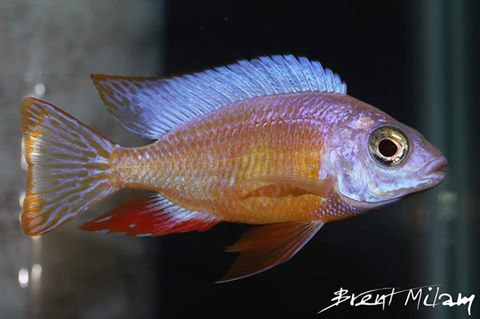|
|
||||
  |
Protomelas steveni taiwan Albino
Protomelas sp. 'Steveni Taiwan' Albino Spawning Report by Thomas Hanley The Protomelas sp. "Steveni Taiwan" is found in Lake Malawi along the Taiwan Reef, from which it receives its moniker. These fish are found at the depth of 50 to 100 feet according to the article written by Ad Konings in the October, 2002 issue of Tropical Fish Hobbyist. Males defend territories of this rocky terrain of about 5 feet in diameter. This fish is only located in a few locations within the lake, although the reason why is not known. They feed on the bio-cover from the rocks and zooplankton in the water column. The appearance of this species of fish is rather striking. The males sport a solid blue face. The blue trails up the top region of the fish and on its dorsal fin. The dorsal also marked with a solid white blaze that starts at the tip of the nose and extends to the end tip of the dorsal fin. The pectoral Fins are a dull brown but the Pelvic fins are a rich orange color, trimmed in blue. Its flanks are a deep orange, with blue starting at its dorsal fin. The anal fin is blue and white at its base, but transitions to a red that is more brilliant than any red that I have ever seen on any Rift Lake cichlid! The females are metallic silver with six lateral lines and two broken horizontal lines that make them appear to have the letter "H" imprinted on them. Other than that, they would be considered to be as drab as any Rift Lake cichlid female.
Acquiring this cichlid took some doing. I searched my regular Internet haunts, which of course included posting for this fish at my friendly neighborhood fish club, the wonderful Greater Cincinnati Aquarium Society. This, after months of searching, turned up nothing. Then on one faithful night, while visiting a fellow club memberís home to pick up some fish from him, I spied something in the corner of one of his tanks. There they were, still small, mind you, but there all the same! I confirmed that they were in-fact Taiwan Reefs. I told Steve Meece that I wanted them and he told me to make an offer. I paid him 25 dollars for the fish. I took the four fish home, and temporarily put the less than two-inch fish into an empty semi-planted 10-gallon tank. The male started to color up soon after I placed them in the tank and they bred about a week after that. Because I could not find much information about this species, I greatly overestimated the time this mouth brooder would hold its eggs/fry. As it turns out, they only hold about two and a half weeks! Well, needless to say, I could not catch the fry and I ended up loosing them all. The next time I saw a female holding I immediately put her in a breeding trap and when she spit, I found 15-20 small (5mm) fry.
This is where this story starts to get interesting. As it turns out, about eight of the fry looked slightly different from the rest of the brood. Although they were still very small, I could see that they were lighter than the rest of the fry. I fed them frozen baby brine shrimp and later the fed on frozen daphnia. As the fry grew larger, I noticed that the differences in the coloration did not subside, in fact, it became more noticeable. Upon closer inspection, I noticed that some of them appeared to have red eyes. Albinos!!! Let me first explain why this excites me so much. During the past year, I have had a slight obsession with albino Rift Lake cichlids. This first started after seeing the famed Albino Aulonocara Eureka Red Peacock, and was further fueled after seeing an Albino Sciaenochromis fryeri on the Cichlidlovers.com website.
Needless to say, I was quite curious as to see what these
mysterious albinos of mine would
These fish are very easy to keep, and a joy to have around. The
water Is changed once every 4 to 5 days, at about 60% each time.
The dominant male albino Taiwan Reef displays a metallic powder
blue color on his face and dorsal fin that continues on to his
caudal fin, which also sports red streaks throughout. The eyes
are blood red and so is its anal fin. Its flanks are a deep
orange.
|
        |
||
|
Banner is of Malawi National Park by Pam
Chin |
||||
